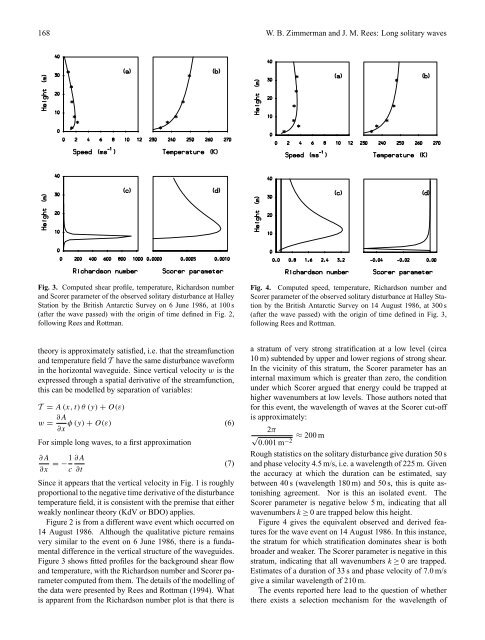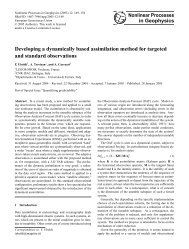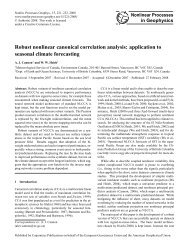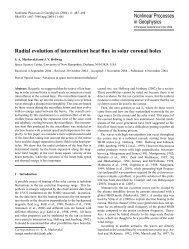Long solitary internal waves in stable stratifications
Long solitary internal waves in stable stratifications
Long solitary internal waves in stable stratifications
You also want an ePaper? Increase the reach of your titles
YUMPU automatically turns print PDFs into web optimized ePapers that Google loves.
168 W. B. Zimmerman and J. M. Rees: <strong>Long</strong> <strong>solitary</strong> <strong>waves</strong><br />
Fig. 3. Computed shear profile, temperature, Richardson number<br />
and Scorer parameter of the observed <strong>solitary</strong> disturbance at Halley<br />
Station by the British Antarctic Survey on 6 June 1986, at 100 s<br />
(after the wave passed) with the orig<strong>in</strong> of time def<strong>in</strong>ed <strong>in</strong> Fig. 2,<br />
follow<strong>in</strong>g Rees and Rottman.<br />
Fig. 4. Computed speed, temperature, Richardson number and<br />
Scorer parameter of the observed <strong>solitary</strong> disturbance at Halley Station<br />
by the British Antarctic Survey on 14 August 1986, at 300 s<br />
(after the wave passed) with the orig<strong>in</strong> of time def<strong>in</strong>ed <strong>in</strong> Fig. 3,<br />
follow<strong>in</strong>g Rees and Rottman.<br />
theory is approximately satisfied, i.e. that the streamfunction<br />
and temperature field T have the same disturbance waveform<br />
<strong>in</strong> the horizontal waveguide. S<strong>in</strong>ce vertical velocity w is the<br />
expressed through a spatial derivative of the streamfunction,<br />
this can be modelled by separation of variables:<br />
T = A (x, t) θ (y) + O(ε)<br />
w = ∂A φ (y) + O(ε) (6)<br />
∂x<br />
For simple long <strong>waves</strong>, to a first approximation<br />
∂A<br />
∂x = −1 ∂A<br />
c ∂t<br />
S<strong>in</strong>ce it appears that the vertical velocity <strong>in</strong> Fig. 1 is roughly<br />
proportional to the negative time derivative of the disturbance<br />
temperature field, it is consistent with the premise that either<br />
weakly nonl<strong>in</strong>ear theory (KdV or BDO) applies.<br />
Figure 2 is from a different wave event which occurred on<br />
14 August 1986. Although the qualitative picture rema<strong>in</strong>s<br />
very similar to the event on 6 June 1986, there is a fundamental<br />
difference <strong>in</strong> the vertical structure of the waveguides.<br />
Figure 3 shows fitted profiles for the background shear flow<br />
and temperature, with the Richardson number and Scorer parameter<br />
computed from them. The details of the modell<strong>in</strong>g of<br />
the data were presented by Rees and Rottman (1994). What<br />
is apparent from the Richardson number plot is that there is<br />
(7)<br />
a stratum of very strong stratification at a low level (circa<br />
10 m) subtended by upper and lower regions of strong shear.<br />
In the vic<strong>in</strong>ity of this stratum, the Scorer parameter has an<br />
<strong><strong>in</strong>ternal</strong> maximum which is greater than zero, the condition<br />
under which Scorer argued that energy could be trapped at<br />
higher wavenumbers at low levels. Those authors noted that<br />
for this event, the wavelength of <strong>waves</strong> at the Scorer cut-off<br />
is approximately:<br />
2π<br />
√<br />
0.001 m −2 ≈ 200 m<br />
Rough statistics on the <strong>solitary</strong> disturbance give duration 50 s<br />
and phase velocity 4.5 m/s, i.e. a wavelength of 225 m. Given<br />
the accuracy at which the duration can be estimated, say<br />
between 40 s (wavelength 180 m) and 50 s, this is quite astonish<strong>in</strong>g<br />
agreement. Nor is this an isolated event. The<br />
Scorer parameter is negative below 5 m, <strong>in</strong>dicat<strong>in</strong>g that all<br />
wavenumbers k ≥ 0 are trapped below this height.<br />
Figure 4 gives the equivalent observed and derived features<br />
for the wave event on 14 August 1986. In this <strong>in</strong>stance,<br />
the stratum for which stratification dom<strong>in</strong>ates shear is both<br />
broader and weaker. The Scorer parameter is negative <strong>in</strong> this<br />
stratum, <strong>in</strong>dicat<strong>in</strong>g that all wavenumbers k ≥ 0 are trapped.<br />
Estimates of a duration of 33 s and phase velocity of 7.0 m/s<br />
give a similar wavelength of 210 m.<br />
The events reported here lead to the question of whether<br />
there exists a selection mechanism for the wavelength of






